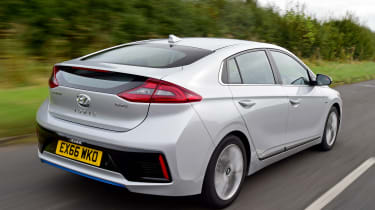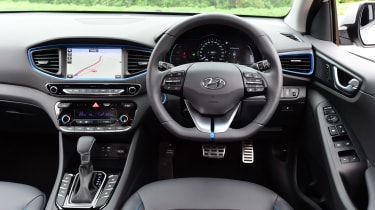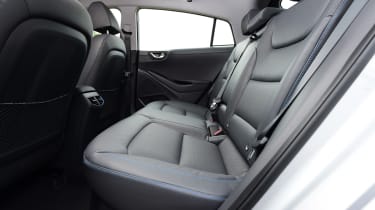Hyundai Ioniq Hybrid 2016 review
We get the new Hyundai Ioniq hybrid on UK roads and find that it's a credible Prius rival

The Hyundai Ioniq isn’t as good a hybrid as the Toyota Prius, but it has price and practicality on its side, so buyers looking for a well equipped, efficient family car should put it on their shortlist. Groundbreaking it isn’t, although the Ioniq has undeniably opened up the prospect of hybrid ownership to a bigger group of buyers and made it even more viable in the process. An EV version is also available, while a plug-in hybrid with a 32-mile electric range will join the range next year.
Hyundai is going in all guns blazing with the Ioniq, offering three alternative powertrain options to tempt buyers out of their conventional hatchbacks and crossovers and into the Korean brand’s efficient new five-door family car.
There’s a pure EV (and a plug-in hybrid due next year), although the petrol-electric Ioniq Hybrid is likely to prove popular, especially as it starts from £19,995 – £3,300 less than Toyota’s cheapest Prius. It even undercuts the Kia Niro, with which it shares much of its underpinnings.
We’ve already driven the Ioniq in Europe, but does the Hybrid make sense on the UK’s more challenging roads?
It uses a 104bhp 1.6-litre petrol engine while its electric motor delivers 43bhp. The big benefit is the e-motor’s 170Nm of torque, though, which is available immediately to provide the Ioniq with impressive acceleration from rest.
The total system output is 139bhp with 265Nm of torque, so if you ask for everything at once the Ioniq will sprint from 0-62mph in 10.8 seconds. Rev it hard and the engine is noisy, though.
Used - available now

2020 Suzuki
SX4 S-Cross
46,548 milesManualPetrol1.4L
Cash £11,997
2020 BMW
X2
44,368 milesAutomaticPetrol2.0L
Cash £14,997
2021 SEAT
Ibiza
18,736 milesManualPetrol1.0L
Cash £14,897
2023 Land Rover
Discovery
13,183 milesAutomaticDiesel3.0L
Cash £57,500Play to the hybrid system’s strengths and it’s relaxing to lope around in, swapping between electric and petrol power as it sees fit. However, this happens too often, even at low speeds. It’s tricky to keep the car in EV mode beyond 40mph, despite Hyundai claiming the maximum EV speed is 75mph.
• Best low emission green cars
The integration of the electric and petrol motors with the six-speed dual-clutch auto gearbox leaves a little to be desired, too. It’s sluggish to change, and on the motorway there’s sometimes an odd surging feeling as the software juggles the two methods of propulsion. There’s also a noticeable step between the regenerative braking system and when the conventional disc brakes take over, so it can make coming to a halt a little jerky. A Prius combines its two power sources better, while its CVT transmission and braking system are also smoother.
On the motorway the Ioniq feels settled unless you hit a big ridge in the road at high speed, but on torn tarmac around town, the firmer, less forgiving damping is at odds with the relaxed powertrain.
The Ioniq weighs just 1,370kg, thanks to some clever weight-saving in areas by Hyundai’s engineers, including aluminium in the bonnet and boot that shaves 12.4kg over standard steel items. Add in the firm suspension and it means you can actually drive the Ioniq fairly quickly, even if the steering isn’t the most involving.
However, this saps efficiency, so it’s better to relax and let the newcomer aim for its claimed 83.1mpg average and CO2 emissions of just 79g/km. Other strengths include the car’s kit and its practicality – the 443-litre boot space is more than the Prius has, helped by the clever location of the battery pack underneath the rear seats.
The Hybrid is available in three trims: SE, Premium and Premium SE. Base-spec cars get plenty of kit, including 15-inch alloys, dual-zone climate control and Bluetooth. Autonomous braking, adaptive cruise and lane-keep assist are also standard.
You have to upgrade to Premium to get sat-nav, although this also provides wireless phone charging, heated seats and keyless go, as well as Apple CarPlay and Android Auto for improved connectivity. The top-of-the-range model we tested has heated and ventilated leather seats, too, but the mid-spec car will be the sweet spot.
The Ioniq has a low drag coefficient of 0.24, so it’s no surprise it shares some styling cues with the Prius. The high rear end and low roofline give it a slippery shape, while the big rear screen is split by a dividing bar. It’s noticeable in your rear-view mirror, but doesn’t really affect visibility.
Inside, the trim quality is entirely acceptable, even if the cabin design is a little dull. Room in the back is also good, so despite the sloping roof even taller adults won’t feel too cramped.











